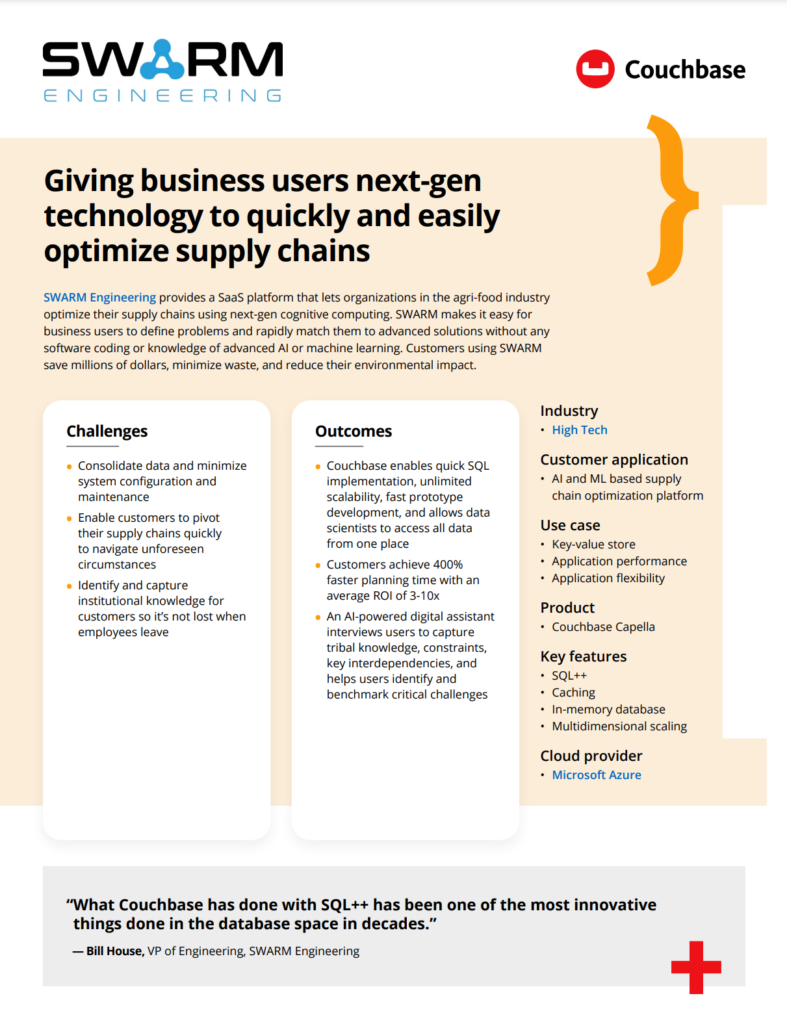The overwhelming narrative heading into the new year has been everything surrounding artificial intelligence (AI) and machine learning (ML). What do these technologies mean for society as a whole, and how will they be incorporated into daily life? A key motivator for business users is increased productivity and efficiency.
The applications for AI at the enterprise level also continue to explode. Numerous Couchbase customers, across a wide range of industries, are planning to utilize AI in their businesses to create a better experience for their customers. SWARM Engineering is one example of a company that is utilizing AI to help transform the businesses of their customers.
SWARM Engineering provides a SaaS platform that lets organizations in the agri-food industry optimize their supply chains using next-gen cognitive computing. SWARM makes it easy for business users to define problems and rapidly find solutions without any software coding or knowledge of advanced AI or machine learning. Customers using SWARM save millions of dollars, minimize waste, and reduce their environmental impact.
Supply Chain Professionals Need to Pivot Faster
SWARM’s platform is typically used by a handful of business users in planning and logistics groups at multinational agriculture companies. Though these groups are small in size, their work has an enormous impact across their organizations. As a result, it’s extremely important that they can make adjustments quickly when their inputs change – for example, if fuel prices spike, bad weather strikes, or transportation issues arise. Excel spreadsheets and other planning tools are simply too time-consuming and inflexible to pivot fast enough.
An AI-Powered Platform Anyone Can Use
One way SWARM helps clients capture and access knowledge is with their AI-powered digital assistant AVA, the first AgriFood Virtual Advisor. Users can work with AVA to identify and benchmark the critical challenges that their business is facing. AVA can also interview operational team members and managers to capture tribal knowledge, constraints, and key interdependencies. When a new user logs in, they can quickly come up to speed simply by asking AVA their questions.
There were numerous reasons SWARM chose Couchbase to meet their needs, including fast prototype development, quick SQL implementation, a key-value store, and unlimited scalability to support future growth. SWARM also wanted the peace of mind provided by Couchbase that once it was set up, it would work reliably without constant tinkering. Having all the data in one place makes it much easier for the data science team to run optimization algorithms and return a speedy solution to clients.
Savings of at Least $1 Million per Optimization
 Most customers come to SWARM because they’re having a major problem with their agri-food supply chain. One example is a labor planning organization that works with a blueberry and asparagus producer in South America. They have to consider many layers of optimization when planning both labor and transportation logistics. For example:
Most customers come to SWARM because they’re having a major problem with their agri-food supply chain. One example is a labor planning organization that works with a blueberry and asparagus producer in South America. They have to consider many layers of optimization when planning both labor and transportation logistics. For example:
-
- Location – Their daily laborers are spread out in remote villages. This encompasses thousands of employees in thousands of different locations who need to be transported to many different fields each day.
- Transportation – To determine which vehicles should be used to transport which employees, they must consider each vehicle’s capacity, whether it has four-wheel drive, and whether it is functioning properly or needs repair.
- Employee skill set – Some workers are more skilled at picking either blueberries or asparagus.
- Weather – In rainy weather, roads may be washed out between the employees and the fields they need to work in.
SWARM refers to this type of situation as a “multi-objective optimization problem.” If a customer provides a clean dataset, SWARM can get them deployed with visible results in as little as three months. Their promise is to save customers at least $1 million per optimization, with an average return on investment of 3-10x. Their reduction in total planning time is around 400% – the SWARM system can accomplish in seconds or minutes what typically takes a human days or weeks, depending on the size of the dataset.
-
- Read the full SWARM Engineering case study to learn more.
- Sign up for Couchbase Capella DBaaS and start testing the cloud, no commitment required.
